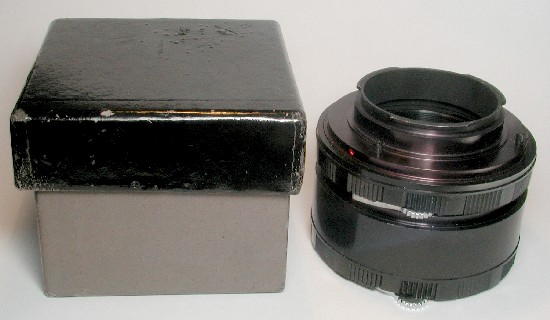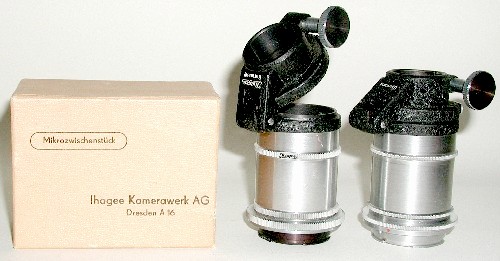Exakta Close-up Equipment
The Exakta System has a great number of accessories for macro and microphotography. Extension tubes, bellows, copying equipment, microscope adapters, and various other items were supplied by Ihagee and other manufacturers.
Close-up Supplementary Lenses (Nahlinsen)
| Perhaps the easiest way to get into close-up photography is via the use of close-up supplementary lenses. Although not supplied by Ihagee, numerous other manufacturers have and are still making them today. Strengths range from a low magnification +1 to a high magnification +10. They are commonly available in kits in millimeter sizes to fit just about any lens. I use a 49mm kit from Tiffen I acquired years ago which has 5 close-up lenses, a +1, +2, +3, +5 and a +10. Just be sure to stop down your taking lens to at least f8 when using these supplementary lenses. |
Extension Tubes (Zwischenringe)
|
In order to focus closer than the closest focusing distance possible with any lens, the photographer has basically two options - use a supplementary close up lens as noted above or via the preferred addition of extension between the lens and the camera . Adding extension can be facilitated most easily via the use of an extension tube set. |
|
Ihagee Tubes for Exakta/Exa Varex-type Cameras The Ihagee Extension tube set consists of 5 pieces. There are three different length extension rings (5, 15 and 30mm long), a 5mm male adapter ring to insert into the camera and a 5mm female adapter ring to accept the lens. The shortest extension (10mm) is achieved by connecting the male and the female adapter rings. The maximum extension (60mm) is achieved by utilizing all three extension rings along with the male & female adapter rings. By varying the number of extension rings, intermediate extension lengths can be achieved. There have been are a number of variations in the appearance of the Ihagee Extension Tube set, for example, locations of the "Ihagee Dresden" engraving, the knurling on the rings, etc. My photo shows two examples. In using extension tubes, additional exposure compensation must be allowed for in determining proper exposure. Any photographic manual can provide these details.
|
 |
|
|
Schacht Tubes for Exakta/Exa Varex-type Cameras Many other manufacturers have made extension tube sets for the Exakta. Some are of marginal quality, while others are more than satisfactory. I have used the tubes manufactured by A. Schacht-Ulm displayed on the right with success. |
|
|
|
Extension Tubes for Exakta RTL Cameras Extension Tube Sets are available for all Exakta models, from the earliest to the latest. The photo on the right shows the special tubes manufactured for the Exakta RTL 1000's. If you look closely at the right side of the tube set below, you can see the pin for automatic diaphragm operation. Several manufacturers also made automatic extension tube sets. |
|
|
|
Extension Tubes for Exakta REAL & Twin TL In addition to the tubes manufactured for the regular Exakta and the RTL models, the next photo shows the extension tube set for the Exakta REAL. Most uncommon, they appear to have been produced by A. Schacht-Ulm. |
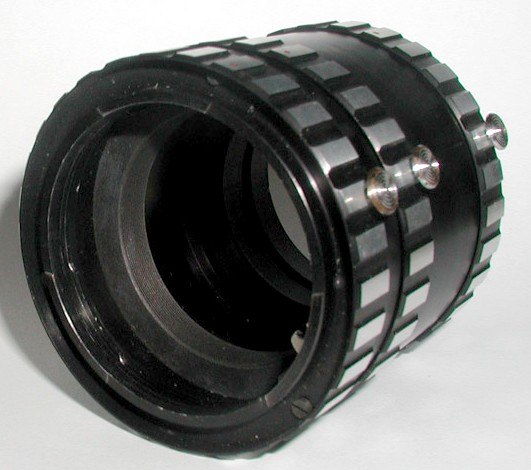 |
The 2-in-1 Ring (Doppelbajonettring, 5mm)
| To bridge the gap between the shortest extension possible with the normal Extension Tube Set (10mm) and not using any extension at all, Ihagee produced the 2-in-1 ring. Also known as a "D" ring, this item allowed for an extension of 5mm when placed between the camera and the lens. It's short length, makes exposure compensation so minimal it can be discounted (less than 1/8th of a stop). | 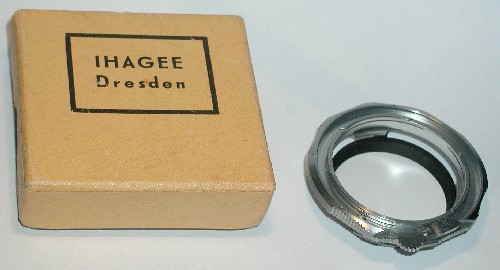 |
The Release Transmission Arm Kit (Auslösebrücke)
|
When an automatic diaphragm Exakta lens is removed from the camera in order to insert an extension tube (or bellows) for close-up photography, the diaphragm step-down plunger on the lens can no longer contact the shutter release button. The engineers at Ihagee came up with a unique solution, the Release Transmission Arm Kit. The device consisted of two different coupling rods and adapter sleeves so that when the coupling rod was connected to the camera release button and then to the lens diaphragm lens plunger, automation of the lens step-down before exposure was again possible. Two different variations were made. The first version is shown installed on a VX 1000 TL with 50mm auto lens and a set of tubes. |
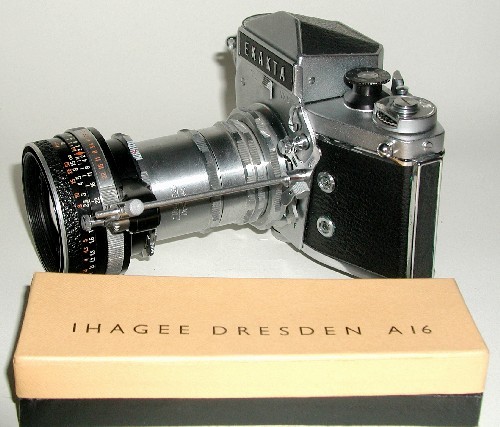 |
| The second version, known in Exakta terms as a "COBRA" release, is shown with its original box. It is a bit easier to use than the first one pictured as it utilizes a large shutter release knob. | 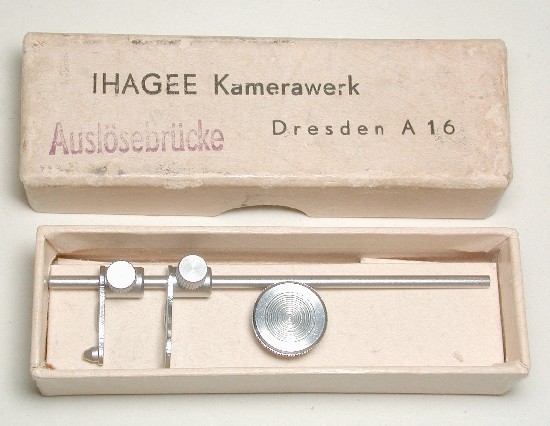 |
While I have personally used both kit versions with success, I personally favor the use of a an adjustable double cable release setup so that the lens can be stepped down first before the shutter is fired.
Double Cable Release (Doppeldrahtauslöser)
|
The use of a double cable release when shooting close-up photos with a bellows or extension tubes is favored over the Release Transmission Arm Kit for several reasons. First and foremost, is less vibration, meaning sharper photos and second, it only takes a few seconds to install. The Exakta Camera Company called the double cable release a "CLOSAL ATTACHMENT". The one shown in my photograph on an Exakta VX, is an adjustable Linhof unit. It can easily be adjusted to have the lens diaphragm stop down before the shutter is fired. Other manufacturers have similar items. |
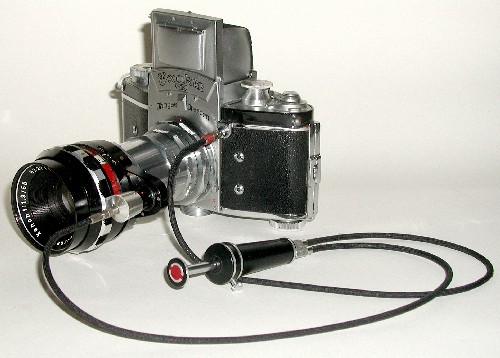 |
Lens Reversal Ring (Umkehrring)
|
When ever reproduction ratios approach or exceed 1.5X, it is advisable to mount the lens in the reverse position. The lens reversal ring screws into the filter thread of the lens being used and then threads on to the front extension tube. It was available in three different sizes (35.5, 40.5 and 49mm) to fit most of the common lenses. The one displayed to the right has 49mm threads and will fit the Auto Pancolors, Tessars, Biotars, Xenons, etc.
|
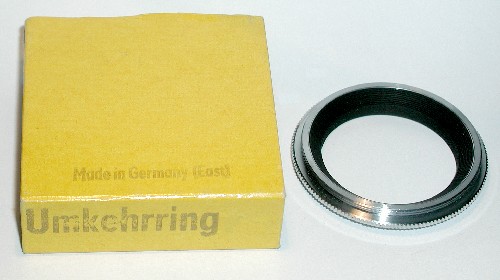 |
Ihagee Bellows 125 Attachment (Balgengerät)
|
Ihagee manufactured two styles of Bellows, the small compact "125" Bellows and the large Vielzweck (Versal) Bellows. The "125" designation arises from the fact that the bellows provides continuous focusing extension from 30 to 125mm. This rather compact bellows is finished in black and is a dual rail model with chrome tubular rails. This model bellows was also known as the Ihagee "Proxette" bellows. Many equipment manufacturers made bellows units for the Exakta. Avoid the flimsy tubular single rail models. Novoflex made several excellent dual rail models. The Multiscope, supplied years ago by Seymours in New York City was an interesting bellows in that it had interchangeable lens boards and if I remember, shift and tilt capabilities for perspective correction.
|
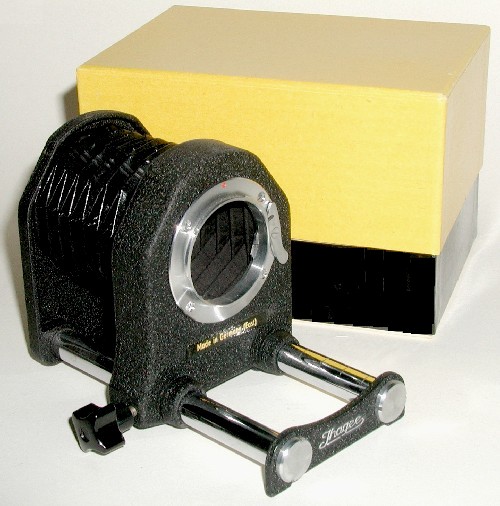 |
Ihagee Vielzweck
The Ihagee Vielzweck, also known as the Versal Assembly, is a multi-component close-up/copying system. The Vielzweck included:
- a large Bellows with a long focusing rail attachment
- a slide copying attachment
- a swing angle attachment (used for shifting the camera from horizontal to vertical)
- a copying stand, compete with wooden base board column and two floodlight reflectors on flexible arms.
|
The Vielzweck was available as an outfit or the components could have been purchased separately. The earlier version was finished in black crinkle finish and was the most attractive in my opinion. Later the system was offered in a blue painted hammertone finish and at least two other color variations are known, gray and aqua green with a third color white as well. I have found the Vielzweck bellows to be rather cumbersome in use. The focusing rail is not geared and the front and rear bellows movements have to be moved back and forth manually and then set with locking levers and/or knobs. A special Carl Zeiss Jena 50mm f2.8 Macro sunken mount Tessar (see my lens section) was offered as an option and provided 1:1 copying of transparencies with the slide copier. |
 |
|
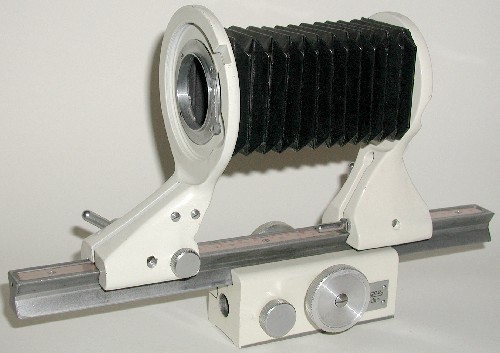 |
Piesker & Co. Bellows
| The Piesker bellows is a very lightweight single rail bellows manufactured in Berlin, Germany. The focusing rail has a pivot joint that enables the rail to be swung up in front of the lens opening for easier storage. While I personally feel that double rail bellows are significantly more rigid and better made, the Pieskar bellows is one of the better single rail units and great for traveling light. |  |
Focusing (macro) Rails (Einstellschlitten)
| While the only focusing rail manufactured by Ihagee was the one that was part of the Vielzweck, I have found through years of experience that a focusing rail is a great tool in macro photography in that it allows the entire camera to me moved back and forth. This is particularly critical when using extension tubes or close-up supplementary lenses that only permit a very limited focusing range. There are many rails on the market today that vary in price from around $50 to $200. The unit that I personally use is an older Novoflex "CASTEL" twin rail unit. It is very light in weight, sturdy and moves the camera back and forth very smoothly. |
|
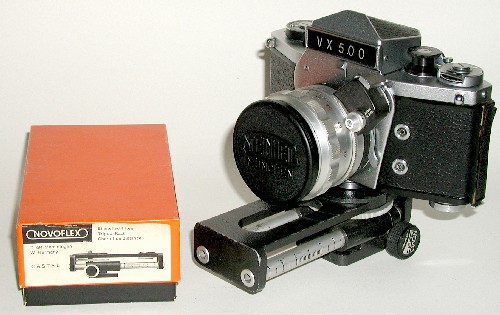 |
Microscope Attachments (Mikrozwischenstück)
Two different microscope attachments were made for the Exakta Varex family by Ihagee. Both attachments permitted the mounting of the Exakta on any microscope having a 25mm diameter eyepiece tube.
|
The Type 1 attachment kept the camera mounted on the microscope at all times. A swing joint on the attachment permitted the camera to be swung aside to permit viewing through the microscope. Two variations are photographed - one is inscribed "Ihagee Germany" on the black base and has a black flange; the other is inscribed only "Germany" and has a chrome flange. Shown in the lower photo, the later Type 2 Microscope attachment was equipped with bayonet flange to permit rapid disassembly. It is much easier to use than its predecessor.
|
|
|
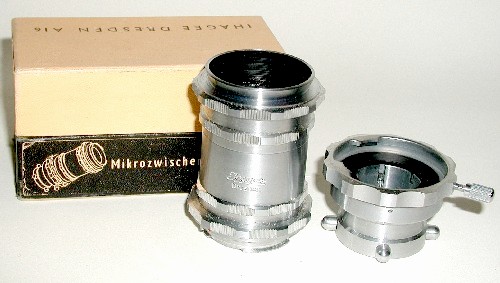 |
Ihagee Microscope Objective Ring (Zwischenringe für Mikrofotografische Objective)
|
In order to attach microscope objectives, having RMS thread (WO.8"x1/36) for high magnification photography, to the Exakta a special ring was made available by Ihagee. Objectives such as the Carl Zeiss Luminars, the Carl Zeiss Jena Mikrotars and some cine-lenses could be used. The photo shows the ring, along with the 25, 40 and 63mm Luminar specialty objectives. As this ring is very difficult to locate, a viable alternative is to have a metal Exakta body cap drilled and tapped by a competent machine shop with the RMS threads. |
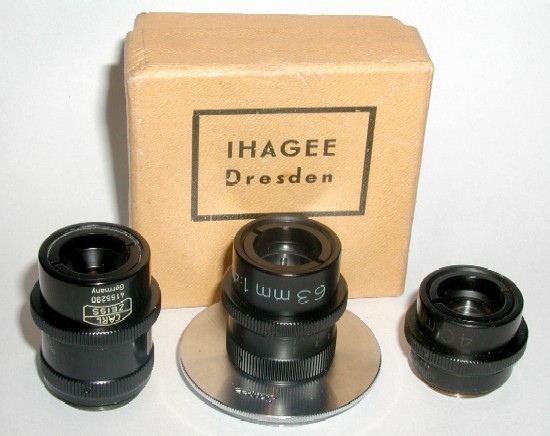 |
Ihagee Ringflash Units RB-2 and RB-1 (Ringblitzleuchte)
|
In close-up and scientific photography, it is often necessary to utilize flash, particularly when working indoors or under less than the brightest shooting conditions. In order to obtain shadowless results, ring flash units are most often used. Ihagee listed several different models. The RB-2 Unit, pictured on the right, is the more common of the two ringflash units offered by Ihagee. It is more suited to everyday close-up flash photography. The diameter of its tube enables its use with 50 and 80mm lenses. Both the RB-1 and the RB-2 need a separate power supply.
|
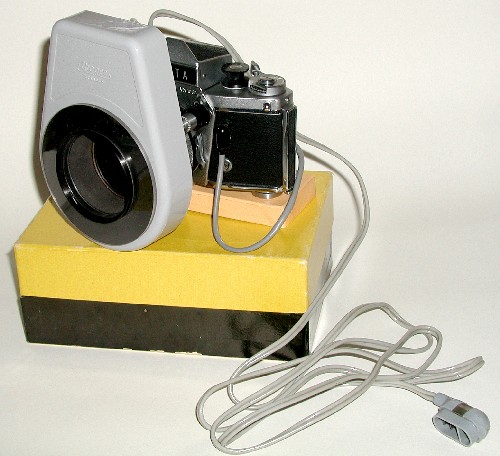 |
|
The RB-1 was the more sophisticated of the two. It had a built-in modelling light for focusing and like the RB-2, required a power supply for operation. Most often used for scientific applications, the RB-1 was quite heavy. The RB-1 is quite uncommon, particularly in the USA. |
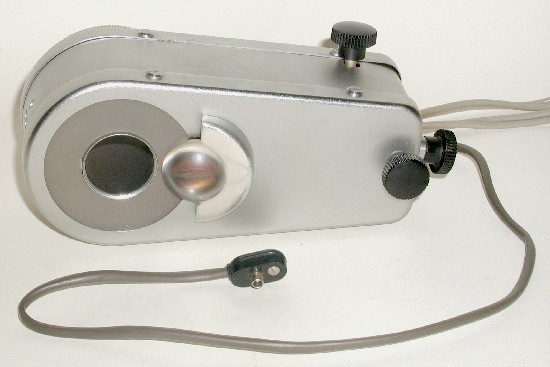 |
| One of the more elusive Ihagee items is the power supply for the Ihagee Ringflash. The photo on the right shows another RB-2 along with its 24 Volt power supply. In order to use it in the USA, a transformer must be used to change the voltage. The power supply has the European-style two prong plug. | 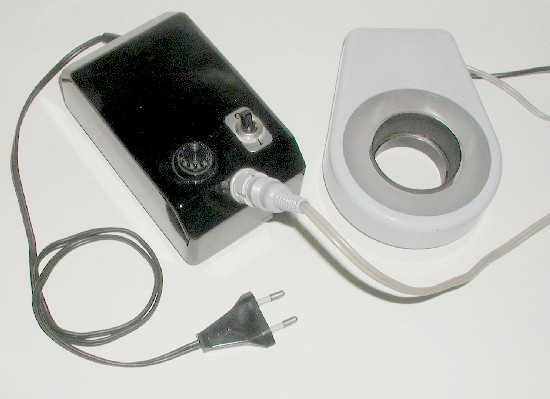 |
Ringflash units have declined in popularity as photographs taken with them are too shadowless and flat in appearance.
Ihagee Macro-Micro Photometer (TTL) (Ihagee-Lichtmeßeinrichtung)
|
ln the late 1950's Ihagee introduced what may be the first ever behind-the-lens TTL meter, the Macro-Micro Photometer. It's use, however, was dramatically different from the TTL meters we have come to know today. It was installed between the lens and the camera and in itself provided a 20mm extension. Once mounted, a selenium cell could be lowered into the light path entering the camera where exposure measurement would be made. Exposure measurement was determined through the use of a micro-ammeter which was connected to the Ihagee meter via two insulated terminal cables. The current was read and exposure determination had to be made via trial calibration of the readings vs. the f-stops used. A number of variations exits in the physical appearance of this meter, most notably on the engravings on the front plate. The most common model has "Ihagee Dresden" engraved in a slight arc with "Germany" engraved on a flat line below it. Two of the most common versions are displayed first, one shows the selenium cell lowered and one raised. The second photograph shows the rare "Varilux" engraved model with its original box and instruction sheet. They were produced in limited numbers. |
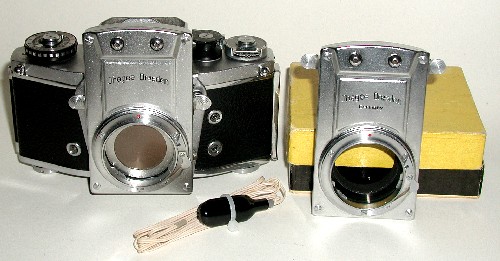 |
|
 |
Gossen Lux Meter
| Rarely seen is the Gossen Lux Meter. It was designed to work specifically with the Ihagee Exposure Meter. Here it is pictured with its' rare leather fitted case. | 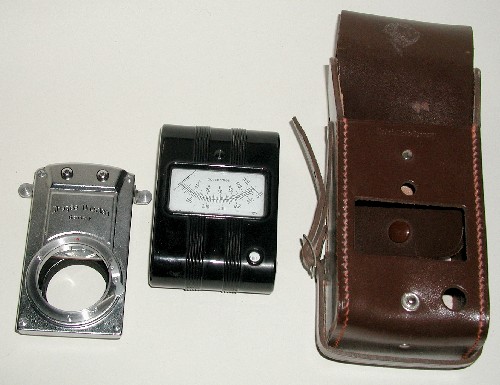 |
Kopil CdS TTL Meter
|
An interesting item!. Once you compose your close-up image, you remove the camera and mount your bellows and lens on this meter from Kopil and take a TTL reading. You then reinstall the camera, set the readings obtained from the meter and take the photo. Device utilizes a Mercury PX625 battery for its power source.
|
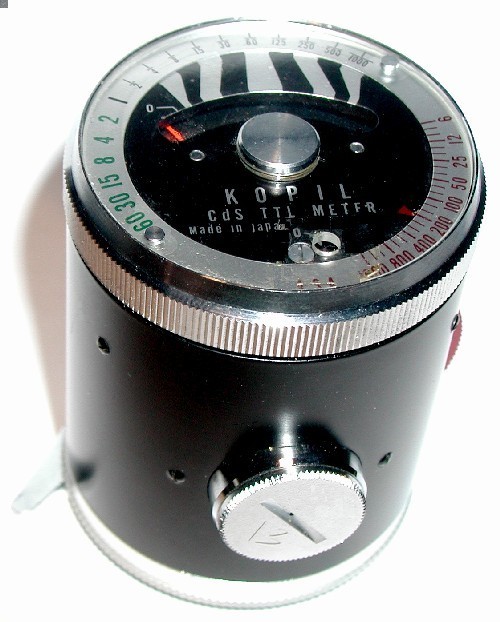 |
Tripods
The MOST important tool in the close-up photographer's arsenal is a good, sturdy tripod. I certainly am discouraging the small, compact lightweight aluminum models currently flooding the market. They have no place in photography. Even the slightest breeze causes them to shake. I recommend using the heaviest tripod that you can comfortably carry and use. I personally own several different model French Gitzo tripods and favor large ball heads with the Foba and Arca-Swiss models being my favorites. While not cheap, they are solid workhorses that will add to your photographic pleasure and last several lifetimes.
Essential Ihagee Macro/Micro Photography Brochure
| Displayed on the left is the official Ihagee brochure covering all of the macro and microphotography equipment in their line. The brochure also covers the Ihagee Stereflex system. | 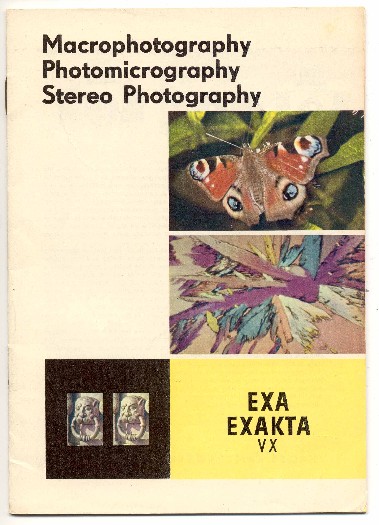 |
Other Close-up Items
Many other specialized close-up accessories have been manufactured over the years. The only Ihagee item I did not mention was the Ihagee Endoscope attachment for medical photography. Don't know if I would want a used one; only God knows the depths it peered into. Ha!
© The material on this web site is copyrighted and the property of Captain Jack. With permission you may hyperlink to my items.

